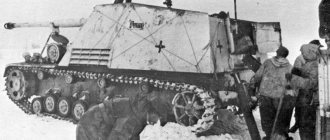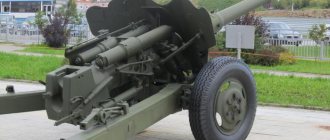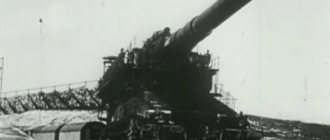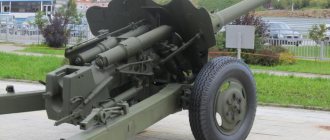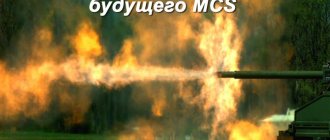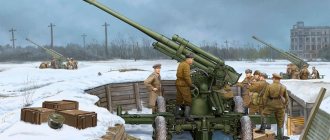"Children's" gun for "adult" war
An old military proverb says: “Every army prepares for the previous war.” This is exactly what the French generals did in the 1930s when planning the production of new anti-tank guns. When they imagined enemy tanks, they saw lumbering, angular boxes moving across the battlefield at walking speed and protected by armor a couple of centimeters thick. To fight them, a small weapon was required that could be easily hidden on a field pitted with craters and moved by crew forces. The result of this concept was the 25 mm anti-tank gun of the 1934 model - Canon 25 mm SA Mle 1934.
The history of this gun began at the end of the First World War, when the famous French began developing a new gun for tanks. Due to the end of the war, the project was shelved and remembered in the early 30s, when the French army was looking for a suitable anti-tank weapon. By placing the barrel of a failed tank gun on a two-wheeled carriage with sliding frames and a small shield, the company cheaply and cheerfully received a very decent anti-tank gun for its time. The prototype, manufactured in 1933, was successfully tested. The gun was adopted under the designation Canon 25 mm SA Mle 1934, that is, a 25-mm semi-automatic [SA - semi-automatique] gun of the 1934 model. In 1934, Hotchkiss received its first order for 200 of these guns.
Design Features
Compared to its “sisters” from field artillery, the 25-mm anti-tank gun looked like a toy, differing in its small size and weight. The designers took a number of additional measures to make it easier to camouflage the gun on the battlefield. In particular, the upper edge of the shield was given a wave-like shape (straight lines stand out more sharply against the background of the terrain) and the barrel was equipped with a cone-shaped flame arrester. The gun was semi-automatic: the bolt opened automatically after firing, ejecting the cartridge case, and the bolt had to be closed manually after loading.
The Hotchkiss gun was anti-tank in the truest sense of the word: its ammunition included only armor-piercing shells of two modifications: with and without a tracer. A projectile with a tracer (the head of such projectiles was painted green) made it much easier for the gunner to adjust aiming, but in some cases (for example, when operating from an ambush), when using it, the risk of unmasking the gun’s position increased. In such cases, projectiles without a tracer (with black heads) were used.
In its design, the projectile resembled an enlarged bullet for an anti-tank rifle: it did not contain an explosive charge, being simply a steel blank. The weight of the projectile was 317 g (in the version with a tracer - 320 g), length - 109 mm. A charge of gunpowder, placed in a voluminous cartridge case 145 mm long, provided the projectile with an initial speed of 920 m/s. According to French data, at a distance of 400 m at an impact angle of 30°, the projectile could penetrate 40 mm thick armor. The report on tests of a captured gun in the USSR is less optimistic: at the same angle of contact, it indicates armor penetration of 36 mm at a distance of 100 m, 32 mm at 300 m, 29 mm at 500 m and 22 mm at 1000 m.
The small caliber and semi-automatic bolt provided the gun with a high rate of fire. The French manuals give data on 20 rounds/min. At the same time, a number of sources indicate other figures: 15 rds/min for fire at a moving target and 25 rds/min for a stationary target. A well-prepared crew could fire even 35 shells per minute - naturally, in this case, there was no question of any adjustment of fire.
The gun was equipped with a telescopic sight with fourfold magnification and a field of view of 11°. The sighting reticle was graduated to a distance of 3500 m. The backup was a mechanical sight, consisting of a front sight and rear sight mounted on a telescopic sight. Its adjustable sighting bar had four positions, corresponding to 400, 600, 800 and 1000 m.
The gun shield, in addition to the wavy upper edge, had one more feature: over a significant part of the area it was shielded by two additional shields placed forward. The carriage had sliding frames and wheels with pneumatics. Thanks to the small mass of the gun (only 475 kg), it could be easily moved across the battlefield by a crew of six people. For this purpose, the gun kit included special straps. During the march, the gun was supposed to be moved by a tractor, but practice has shown that its design is too delicate, and therefore sighting devices and other components often break. As a result, we had to limit the towing speed: 15 km/h over rough terrain; 30 km/h - on the highway. Attempts to solve this problem led to the appearance of a palliative - a special trailer with sprung wheels, on which a weapon was mounted for towing behind the tractor. This technique, widely used for outdated artillery systems, looked quite absurd in relation to the new gun, which was originally designed for mechanical propulsion, nevertheless it gained some popularity. Another way to increase mobility was to transport a gun in the back of a tractor.
The small mass of the gun made it possible to move it using crew forces. Vauvillier F. Le Canon de 25 mm antichar modele 1934 Hotchkiss
In 1937, a new modification appeared - Canon 25 mm SA-L Mle 1937, developed (the letter “L” stood for leger - “light”). The mass of this gun was only 310 kg. Externally, it was distinguished by a modified form of the shield and flame arrester. The bolt and trigger mechanism were also improved, which increased the rate of fire.
A total of 4,225 copies of the Canon 25 mm SA Mle 1934 and 1,285 Canon 25 mm SA-L Mle 1937 guns were produced by May 1, 1940. The 25 mm anti-tank guns were to be replaced by a new, more powerful Canon 37 mm SA Mle gun 1937, but its production unfolded extremely slowly. Therefore, in 1934, another attempt was made to modernize the 25 mm gun. The variant, designated as Canon 25 mm SA Mle 1934 modifie 1939 (“25-mm semi-automatic gun model 1934, modification 1939”), received a more durable carriage, which made it possible to remove restrictions on towing speed. The Army ordered 1,200 of these guns, with deliveries scheduled to begin in June 1940. Whether the customer received at least the first batch of these guns is unknown.
Combat use
By the beginning of World War II, the 25 mm gun was the main anti-tank weapon of the French army. According to the states, each infantry division had 52 such guns: 12 in each of the three infantry regiments (including 2 in each battalion and 6 in the regimental anti-tank company), 12 in the divisional anti-tank company, 4 in the reconnaissance group. In terms of the number of anti-tank weapons, the French infantry division was significantly inferior to the German one, whose staff included seventy-five 37-mm Pak anti-tank guns.
Combat work of the Canon 25 mm SA Mle 1934 crew. Vauvillier F. Le Canon de 25 mm antichar modele 1934 Hotchkiss
Other formations of the French army also had 25-mm cannons, although in noticeably smaller numbers. In particular, the light mechanized division had 24 such guns (12 each in the dragoon regiment and the divisional anti-tank squadron). The light cavalry division had 28 such guns (8 in the dragoon regiment, 4 each in two cavalry regiments, 12 in the anti-tank squadron). Finally, the tank division had only a dozen 25 mm anti-tank guns. To complete the picture, we note that four of these guns were in the reconnaissance groups of the army corps.
The battles of May - June 1940 showed that in capable hands the 25-mm cannon is a fairly effective anti-tank weapon. The episode that took place in the Belgian city of Gemblois on May 14–15 became textbook. An anti-tank gun crew under the command of Corporal Louis Brindejon from the 2nd Moroccan Rifles Regiment managed to knock out seven German tanks (three Pz.Kpfw. II and four Pz.Kpfw. III) from the German 4th Panzer Division. The French fired from a distance of 600 m, and the gun was so skillfully camouflaged that the German tank crews were never able to destroy it. It was possible to break through the Brindejon-controlled intersection only when the crew of the Fi 156 aircraft discovered the position of the gun and marked it with a smoke candle. As a result of the mortar attack, the gun was disabled and all French soldiers were killed or injured. Brindejon himself was wounded and captured, but managed to survive until liberation and died in 2010 at the age of 92.
Abandoned Canon 25 mm SA-L Mle 1937 cannon. France, 1940. smolbattle.ru
The effectiveness of the 25-mm cannon was also recognized by the Germans. Colonel Kühne of the 3rd Panzer Division noted:
“The fire accuracy of the French 25mm anti-tank gun is very good. The frontal armor of the Panzer III is easily penetrated by shells from an excellent French gun...”
However, not all anti-tank artillery units used their guns as skillfully as Corporal Brindejon’s crew. In most cases, 25 mm guns were powerless even against the relatively “thin-skinned” German vehicles of the Blitzkrieg era in the West. One of the participants in the battles of May - June 1940, the commander of the 25-mm cannon crew, Corporal Jean Dupont, outlined his impressions in the article “Fighting Tanks,” published in April 1941 in the American magazine Field Artillery Journal. DuPont recalled:
“My crew of a 25-mm cannon fired at three tanks. One was stopped, the other was delayed only a couple of minutes; the third remained unharmed, despite the fact that we fired many shells at him from a distance of some 50 yards.
The problem was that a number of French units did not receive a sufficient number of 25-mm guns. Thus, the 71st Infantry Division went into battle with only 25% of the anti-tank weapons provided by the state.
"Career" abroad
France transferred two hundred 25-mm cannons to the British, receiving in return Boyce anti-tank rifles. In the British Army, these guns were designated 25 mm Hotchkiss Mark I. They were used not only by the British Expeditionary Force in France, but also by the contingent participating in the Norwegian Campaign. The most famous combat episode with their participation took place in Norway. On April 23, 1940, a German column consisting of a Pz.Kpfw light tank approached the positions near the city of Andalsnes, which were defended by two companies of the Royal Yorkshire's Own Light Infantry Regiment. II, armored car Sd.Kfz. 231 and a three-turreted NbFz tank. They were followed by infantry (some on trucks, some on foot). As soon as the head of the column entered the valley of the Lagen River, a 25-mm cannon assigned to one of the English companies opened fire. Firing from a distance of about 400 m, the gunners managed to immobilize the NbFz., damaging its chassis, and then disable the light tank. The German armored car had no choice but to leave the battle. Thus, a small-caliber anti-tank gun was able to neutralize the heaviest German tank as of 1940.
The French handed over two hundred Canon 25 mm SA Mle 1934 cannons to the British. acemodel.com.ua
Transporting 25-mm guns in the back of cars was a necessary measure due to the fragility of their carriages. acemodel.com.u
After the defeat of France, very few 25-mm anti-tank guns remained in the hands of the British - mainly those that were evacuated from Norway. They were used for training purposes until the ammunition was completely spent (the release of 25-mm shells was considered inappropriate due to the small number of such guns).
Finland, shortly before the start of the Soviet-Finnish War, ordered 50 Canon 25 mm SA-L Mle 1937 cannons from France, but managed to receive only 40, and only 20 of them took part in battles. The last batch of ten guns destined for Finland was captured by the Germans in Norway. After the defeat of France, the Finns acquired a large batch of captured 25 mm guns from the Germans (200 units - 133 Canon 25 mm SA Mle 1934 and 67 units - Canon 25 mm SA-L Mle 1937). French 25 mm guns were used by the Finns until 1943, designated 25 PstK/34 and 25 PstK/37 and even had the unofficial nickname “Marianne”.
In the Finnish army, the Canon 25 mm SA Mle 1934 gun was designated 25 PstK/34. SA-kuva, photo No. 963
Anti-tank gun 25 PstK/37 and its crew. SA-kuva, photo No. 2448
In the Wehrmacht, the Canon 25 mm SA Mle 1934 guns were designated Pak 112(f), and the Canon 25 mm SA-L Mle 1937 guns were designated Pak 113(f). The Germans used them in parts of the second and third lines - mainly in the territory of the occupied countries of Western Europe. A certain number of Hotchkisses also ended up with the Italians, who adopted them under the name Cannone a 25/72 and subsequently used them in North Africa.
Canon 25 mm SA Mle 1934 guns - German trophies from 1940. smolbattle.ru
The Renault UE transporter was the standard tractor for 25 mm anti-tank guns in both the French and German armies. smolbattle.ru
An improvised anti-tank self-propelled gun is a Pak 112(f) gun mounted on a Renault UE tracked transporter. smolbattle.ru
In North Africa, a number of Canon 25 mm SA Mle 1934 cannons were used by Free French troops, including as improvised self-propelled guns: the cannon was mounted on a “marine type” stand in the back of a Dodge WC-51 car.
The general assessment of 25-mm anti-tank guns was, willy-nilly, influenced by the defeat of France in 1940.
Yes, Hotchkiss couldn't prevent it, but in a number of episodes these little guns showed themselves to be very worthy. On the one hand, good armor penetration and high rate of fire made it possible to hit the German tanks of that time. On the other hand, the gun did not have the reserves to further improve its armor-piercing characteristics (and the need for this became obvious already in 1941, when many tanks with anti-ballistic armor entered the battlefield). This partly explains the rather modest use of captured 25-mm guns by the Germans. Another drawback, also caused by the small caliber, was the lack of a fragmentation projectile in the cannon’s ammunition, which did not allow it to be used for any other tasks other than fighting tanks. Thus, 25-mm guns “outgrew” anti-tank guns, but, alas, did not reach the level of “real” guns. Tactical and technical characteristics of the Canon 25 mm SA Mle 1934 gun
| Caliber, mm | 25 |
| Barrel length, calibers | 72 |
| Weight of gun, kg | 475 |
| Length of gun in traveling/combat position, m | 3,57/3,46 |
| Width of gun in traveling/combat position, m | 1,04/2,53 |
| Carriage wheel track, m | 1 |
| Height at the top edge of the shield, m | 1,1 |
| Vertical aiming angle, degrees. | –5, +15 |
| Horizontal aiming angle, degrees. | 60 |
| Rate of fire, rds/min | 15–35 |
| Practical/maximum firing range, m | 1000/1800 |
Bibliography:
- Chamber P., Gander T. Anti-Tank Weapons. — New York, 1974.
- Henry C. British anti-tank artillery. — Oxford, 2004.
- Męczykowski Ł. Canon 25 mm SA Mle 1934 - krótka charakterystyka // Militaria XX wieku. - 2010. - No. spec. 2.
- Vauvillier F. Le Canon de 25 mm antichar modele 1934 Hotchkiss // Histoire de Guerre, Blindes & Materiel. - 2007. - No. 77.
Korean debut
The S-60 complex, which had just entered service with the troops, was almost immediately tested in combat in the Korean War. There, the insufficient firing range of the AZP-37 was once again confirmed. The anti-aircraft gunners' positions were subject to attacks from American aircraft from a distance greater than their affected area.
The S-60 guns, in turn, proved their effectiveness, but then suddenly loading failures began to occur. The designers' nerves were frayed a lot before the true cause of the failures was revealed. It turned out that the manufacturer, in the best traditions of Soviet industry, “out of production necessity,” replaced the steel in the springs with another, after which they ceased to withstand the load.
The gun was made reliable, and representatives of the design bureau were sent to the PRC to help the fraternal country master the production of the S-60, which the Chinese then sold on their own behalf to everyone as the “Type-59.” As in many other cases, the USSR generously shared its technological developments with the country of “people's democracy”, while managing to not protect its copyright in any way.
Serial production of the S-60 was carried out from 1950 to 1957. Barrels and installations were manufactured at factories No. 4, No. 7, No. 92, No. 235 and No. 946. A total of 5,725 guns were produced, which were delivered to approximately 60 countries. To this day, hundreds of S-60s continue to remain in service or at least in storage.
The S-60 could not protect troops on the march, as it needed preliminary deployment, so an anti-aircraft self-propelled gun with a twin version of the S-68 gun was created. The right gun was “mirrored” in order to place the loading trays on both sides of the “spark”, the left and right were moved as closely as possible, for which one of the barrels even had to be moved a little back. A pair of cannons were placed in an open turret, literally pushing the ammunition load into all possible corners of it, greatly hampering the work of the crew.
The body of the “Object 500” anti-aircraft self-propelled gun was created in the dimensions of the T-55 tank from thin armor plates and elements of the tank’s chassis, reducing the number of rollers by one due to weight savings due to armor.
The anti-aircraft self-propelled gun was adopted as the ZSU-57-2, but since the guns lost their fire control system, instead of which only a simple sight was left, the fire efficiency became unsatisfactory. A more advanced model of the ZSU-57 with a closed turret and a fire control system, including an on-board radar, could not be created under the Dnepr program - the dimensions of the electronics of that time did not allow it.
Well, in tank and motorized rifle regiments that never received the ZSU-57 in sufficient quantities, S-60 batteries were often in immediate service, despite all their cumbersomeness.
© wikimedia.org
AK-725
Possible impact
Wasserfall(Germany)
No influence. Wasserfall was objectively too complex and large-scale a project to be completed in a reasonable time.
The design of the rocket contained many shortcomings associated with haste during development and insufficient understanding by German rocket scientists of a number of key issues. The only available control system was hopelessly compromised and extremely vulnerable to electronic warfare. After the war, both the USA and the USSR tried for a long time and to no avail to modify the captured Wasserfall to a combat-ready state - but in the end they came to the conclusion that it would be easier and faster to develop a new missile from scratch. This assessment should be considered a verdict on the German rocket.
Rating: One point.
DAAC(Italy)
The possible impact is quite significant, since it was quite possible for DAAC to be brought to fruition not to the end, but to the middle of the war. Had the Italian military command shown more foresight, the Campini missile would have entered service as early as 1942-1943, radically strengthening the air defense of the Italian fleet and significantly weakening the importance of Allied air superiority.
In addition, as the German experience with the development of Schmetterling showed, the Italian rocket had significant modernization potential.
Rating: Five points.
Funryu-2(Japan)
The impact is minor. Of course, Japanese anti-aircraft missiles would cause some trouble for the Americans, but still they became a typical example of too little, too late. In addition, the ceiling of Funryu-2 was insufficient to defeat heavy bombers.
However, a massive deployment of these missiles in 1945–1946 would have been an unpleasant surprise and likely would have forced the Americans to abandon low-altitude bombing.
Rating: Three points.
Brakemine(UK)
The potential impact is significant but limited. The development of Breakmines proceeded slowly due to the lack of a direct need, but if one arose, the work could be significantly accelerated. If the war in Europe had dragged on for another six months to a year, Breakemina would have been the best British answer to the German jet bombers and the new Luft'46 projectile aircraft.
Rating: Four points.
KAN Little Joe(USA)
The possible impact is significant but limited. Little Joe's missiles were being prepared for landing in Japan and would undoubtedly be an effective argument against Japanese kamikazes. However, by the time they appeared, the course of the war was already completely predetermined.
Rating: Three points.
Description and characteristics of the weapon
The 70-K anti-aircraft gun had a monoblock barrel, a screw-on breech and a vertical wedge breech. The ZAU automation operated using the recoil energy of the barrel during a short recoil of the barrel. The machine was fed with cartridges - continuous, vertical, using 5-round clips. The recoil involved a throw-type spring rammer connected to the breech.
The cooling of the AU was air-based and was unsuccessful: for example, a 37-mm air-cooled barrel had a continuous burst length of only 100 shots, compared to no less than 158 for a water-cooled barrel. After 100 shots, the air-cooled barrel either had to be replaced or wait about 1.5 hours for it to cool down.
- Number of guns in the AU - 1
- Total barrel length, mm/calibers - 2720/73.5 (with flash suppressor)
- The length of the threaded part is 2054
- Chamber volume - 0.267 dm³
- Number of grooves - 16
- Rifling stroke length - 25 klb
- Rifling depth - 0.45 mm
- Vertical guidance speed (manual) - 15 degrees
- Horizontal guidance speed (manual) - 19.6 degrees
- Rollback length - 150-170 mm
- Fire line height - 10195 mm
- Swing radius, muzzle/breech - 2800/1080 mm
- Weight of the swinging part - 555 kg
- Weight of the recoil parts of the barrel - 127.5 kg
- Weight of the rotating part - 1100 kg
- The total weight of the propeller is 1350 kg
- Calculation - 5-6 people.
- Initial projectile speed - 880 m/s
- Ballistic firing range - 8400 m
- Ballistic firing range for self-liquidator - 4000 m
- Mass of fragmentation tracer cartridge/projectile - 1496/732 g
- Weight of armor-piercing tracer cartridge/projectile - 1522/758 g
- Weight and brand of gunpowder - 210 g (gunpowder grade 7/7)
Literature and sources of information
Literature
Berezhnoy S.S. Soviet Navy 1945-1995. - “Marine Collection”. - M.: Modeler-designer, No. 1/1995. — 32 s.
Zablotsky V. P. “Universal project.” SKR, BPK, DBK, EM and frigates of projects 61, 61M, 61MP, 61ME, part I. - “Marine Collection”. - M.: Modeler-designer, No. 10/2009. — 32 s.
Zablotsky V. P. “Universal project.” SKR, BPK, DBK, EM and frigates of projects 61, 61M, 61MP, 61ME, part II. - “Marine Collection”. - M.: Modeler-designer, No. 11/2009. — 32 s.
Kostrichenko V.V., Prostokishin A.A. “Singing frigates.” Large anti-submarine ships of Project 61. - “Maritime Collection”. - M.: Modeler-designer, No. 1/1999. — 32 s.
Links
- Wikipedia page about Nadezhny-class BOD/Rajput-class destroyers
- Wikipedia page on Reliable-class BOD/Rajput-class destroyers
- Photos of the BOD "Reliable" / "Rajput" on navsource.narod.ru
- Photos of the BOD "Destructive"/"Rana" on navsource.narod.ru
- Photos of the BOD "Lovkiy" / "Ranjit" on navsource.narod.ru
- Photos of the BOD "Tverdy" / "Ranvir" on navsource.narod.ru
- Photos of the Tolkovy/Ranvijay BOD on navsource.narod.ru
Concept
The First World War provided rich experience in the use of all types of weapons and stimulated the activity of the military and designers in the field of creating new systems. Based on the generalization of this experience, as they say, “hot on the heels,” the British Army already in 1919 put forward requirements for a promising field weapon. The new gun was supposed to replace the two main artillery systems of the war years - the 18-pounder (83.8 mm) gun and the 4.5-inch (114.3 mm) howitzer. Both of these weapons - each in their own way - were good, but they also had certain disadvantages. In particular, the 18-pounder projectile had a good initial velocity, but the gun had a very low elevation angle. Therefore, it was successfully complemented by a howitzer with a mounted firing trajectory. The new system was supposed to combine the advantages of both guns, that is, to become a howitzer gun.
Development was carried out slowly - after all, there was no foreseeable war in the foreseeable future. It was not until 1924 that two howitzer designs were submitted to the Royal Artillery Committee for consideration - the 3.9-inch (100 mm) QF and the 4.1-inch (105 mm) BL. In this case, the first option provided for the use of unitary shots, and the second - separately loaded shots 1 . But both systems were rejected because they did not provide the required firing range of 15,000 yards (13,725 m) - their designers promised only 13,000 yards (11,895 m). In 1928, the Director of the Royal Artillery, Major General J. H. Lewis, proposed a 3.7-inch (94 mm) gun-killer, but this was not accepted. Thus, the British army was left without a new artillery system, continuing to operate guns from the First World War. Meanwhile, arms concerns were producing modern guns for export - for example, back in 1922, Vickers designed a modern 105-mm howitzer for the Spanish government, which was then supplied to other countries.
18-pounder howitzer gun, which formed the basis of the 25-pounder
Only a decade and a half after the end of the war, in October 1933, a fundamental decision was made in Britain about the caliber of the promising system. The choice was made at 3.45 inches, or 87.6 mm in the metric system, since the use of a larger caliber made it impossible to upgrade the old 18-pounder guns to new ammunition. In February 1938, the caliber designation in inches for howitzers was changed to a “cannon” designation in pounds - so the 3.45-inch gun became a 25-pounder. This emphasized that the new system should become primarily a cannon, and only secondarily a howitzer. In September 1934, the official General Staff specification was prepared, and the Director of the Royal Artillery, Major General Lewis, finally issued an order to the Wicker-Armstrong concern for the production of the first prototype.
Modernization and refurbishment
Launch of a Brahmos missile from the destroyer Rajput, February 12, 2003
In the Indian Navy, Project 61ME ships have become the objects of a number of modernizations, both to modernize their weapons and to test new models. In particular, the Cleaver air target detection radars on all destroyers of the series were replaced by new Israeli-developed EL/M-2238 radars.
The lead "Rajput" became the first ship experimentally armed with the latest supersonic missile "Brahmos"
.
During the 2003 modernization, one P-20 anti-ship missile container on each side was replaced with twin Brahmos installations, so that the strike armament of the modernized destroyer began to consist of two P-20 missiles and four Brahmos missiles. The name of the new rocket is “Brahmos”, in English. BrahMos
is derived from the first syllables of the names of the Brahmaputra and Moscow rivers, which reflects the joint Russian-Indian nature of the development. The missile was developed in ship, ground and aviation versions. In the ship version, the 3-ton missile delivers a 200-kilogram warhead over a distance of up to 450 kilometers; Thanks to the ramjet engine, it reaches speeds of up to 3,700 km/h in flight and flies at an altitude of only 3-4 meters. The highest speed and low flight altitude make it highly vulnerable even to the most modern means. The basis of the Brahmos design was the Soviet Onyx/Yakhont cruise missile. In addition to retrofitting the Brahmos, during the modernization the Rajput destroyer was also equipped with the Indian Bharat-Ajanta electronic warfare system, and also replaced the Angara-A surveillance radar with the newer Bharat RAWL radar.
The newest ships of the project - "Ranveer" and "Ranvijay" - between 2007 and 2009 underwent significant modernization with the replacement of a significant part of the weapons. Instead of the aft-mounted Volna air defense system, a vertical launch system was installed on eight Brahmos supersonic cruise missiles, and instead of two of the four 30-mm turrets of the AK-630 complex, 8-charge Barak air defense missile launchers were installed on the side.
Israeli development. Thus, these two small destroyers now carry four different types of missile systems: two strike missiles each (P-20 with 4 missiles and Brahmos with 8 missiles) and two anti-aircraft missiles each (Volna and Barak, 16 missiles each).
